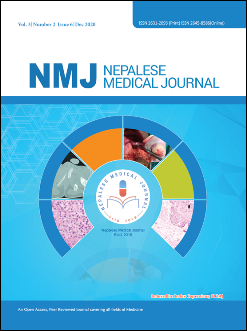Pre-stenting for Retrograde Intrarenal Surgery: Need and Duration: a Prospective Randomized Clinical Study
DOI:
https://doi.org/10.3126/nmj.v3i2.33050Keywords:
Pre-stenting; Retrograde intrarenal surgery; Ureteral access sheathAbstract
Introduction: To evaluate if retrograde intrarenal surgery with ureteral access sheath requires prestenting. In case pre-stenting becomes an option, how long does it need to be stented.
Materials and Methods: After obtaining approval from Institutional Review Board and informed consent, a prospective randomized controlled study was conducted in the Department of Urology, Bir Hospital for 18 months. All the patients enrolled for retrograde intrarenal surgery were grouped into 3 groups: Group 1 – without pre-stenting, Group 2 – one week of pre-stenting, and Group 3 – two weeks of pre-stenting. Success was defi ned as an ability to accommodate a 10/12 F ureteral access sheath during retrograde intrarenal surgery. Ureteral access sheath induced ureteric wall injury was also taken into consideration.
Results: Among 179 cases, 152 cases were included in the study. In 36 patients out of 53 (67.92%) in group 1, 10/12 F ureteral access sheath was negotiable without pre-stenting, marking the frequency of distensible ureters. In 44 patients out of 47 (93.66%) from group 2 and all 52 patients (100%) from group 3, ureteral access sheath placement was successful after one and two weeks of pre-stenting respectively. Ureteric wall injury of grade1 and 2, was found in 9 patients (5.9%).
Conclusions: The majority of ureters (67.92%) are distensible, not requiring pre-stenting before retrograde intrarenal surgery. One and two weeks of pre-stenting carries a success rate of 93.66% and 100% respectively.
Downloads
Downloads
Published
How to Cite
Issue
Section
License
This license enables reusers to distribute, remix, adapt, and build upon the material in any medium or format, so long as attribution is given to the creator. The license allows for commercial use.
Copyright on any article published by Nepalese Medical Journal is retained by the author(s).
Authors grant Nepalese Medical Journal a license to publish the article and identify itself as the original publisher.
Authors also grant any third party the right to use the article freely as long as its integrity is maintained and its original authors, citation details and publisher are identified.




